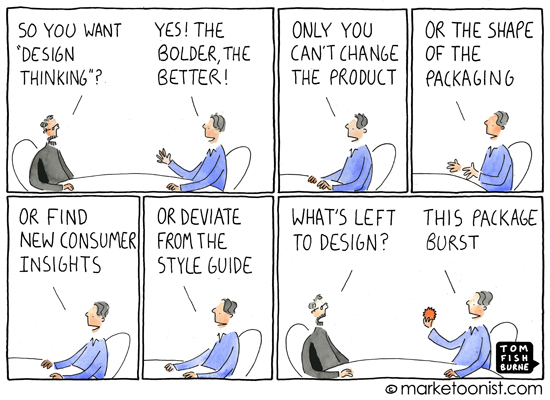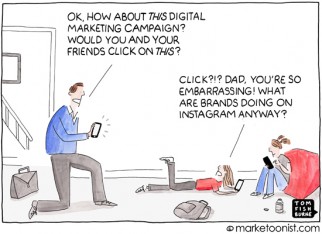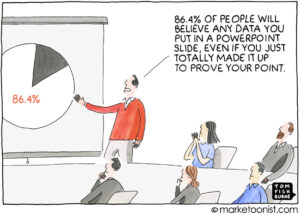Design Thinking is one of the more hyped (and frequently misunderstood) terms in business. Many companies have jumped on the Design Thinking bandwagon without really knowing what it means. The term is frequently trotted out to describe just about any organization — even organizations with a pretty superficial appreciation of Design.
Sometimes the Design Thinking term gets confused with its props and artifacts. It can be easy to assume that all an organization needs to “do” Design Thinking is an offsite, a whiteboard, and a stack of sticky note pads. As a result, Design Thinking has lost much of its meaning.
IDEO popularized the methodology of Design Thinking. Here’s how IDEO CEO Tim Brown defines it:
“Design thinking is a human-centered approach to innovation that draws from the designer’s toolkit to integrate the needs of people, the possibilities of technology, and the requirements for business success.”
Underlying this methodology is an appreciation for Design as a discipline. As Tim describes in his classic HBR article:
“Historically, design has been treated as a downstream step in the development process—the point where designers, who have played no earlier role in the substantive work of innovation, come along and put a beautiful wrapper around the idea.
“Now, however, rather than asking designers to make an already developed idea more attractive to consumers, companies are asking them to create ideas that better meet consumers’ needs and desires. The former role is tactical, and results in limited value creation; the latter is strategic, and leads to dramatic new forms of value.”
Here are a few practical resources I’ve found on how to start adopting Design Thinking:
- Stanford D-School Introduction To Design Thinking: This is a nice high-level primer on the process of Design Thinking. The D-School was started by D-School Founder David Kelley.
- Talking to Humans: This is a very cool practical guide on the “human-centered” part of Design Thinking (free PDF here). It was created by Giff Constable of Neo and Frank Rimalovski of the NYU Entrepreneurial Institute. I’m admittedly biased because I had a chance to collaborate with them on cartoons for every chapter.
- Google Ventures Design Sprint: This is a wonderful DIY resource on how to hold a Design sprint in any organization.
I’d love to hear your thoughts on Design Thinking.
(Marketoonist Monday: I’m giving away a signed cartoon print. Just share an insightful comment to this week’s post by 5:00 PST on Monday. Thanks!)
Here’s a related cartoon I drew in 2012:




Paul (from Idea Sandbox) says
I’ve noticed that some companies using “design thinking” as a fancy replacement term for “brainstorming.” But, neither truly following a brainstorm strategic process nor a design thinking process.
Nice work, Tom!
Jason F says
Consumer insights and design have been fundamental in recent brand programs I’ve managed for my clients, who turn to us as marketing consultants while they have product and operations expertise.
I look forward to reading the reference documents you provided.
Thank you, Tom!
Ori Pomerantz says
Actually adopting better ways of doing things is hard work. As long as they’re held accountable by people (who can be tricked) rather than the market as a whole, middle managers can get almost the same result by pretending.
Patrick (from gravitytank) says
Nice post, Tom!
At gravitytank, human-centered design/design thinking is core to our efforts designing new products and services for companies across a range of industries.
Design Thinking typically supports innovation efforts. We believe Innovation can be distilled down to a core set of behaviors, the Six Principles to Work Differently.
We encourage our peers, clients, and others to utilize the wealth of resources (ranging from videos to method cards) we have created to enable them Work Differently, and drive innovation in their organizations: http://www.gravitytank.com/workdifferently
Design Thinking is an invaluable tool for generating new ideas that resonate with consumers. But over the past 15 years, we’ve learned that Design Thinking alone isn’t enough to bring innovative new products and services to market; good ideas are no longer good enough.
Organizations need help constructing a path from design thinking to market entry. They need help shepherding new products and services into the world even when champions leave, stakeholders get embroiled in politics, and short-term P&Ls must be managed. They need help being lean, relentless, and resourceful.
The design industry is in a state of flux, but we think the future is bright for firms that can enable their clients behave with the boldness of startups to incubate the visions that they’re most excited about –initiatives that combine creative DNA with the determination of execution.
You can read more about our vision for this future on Medium: http://bit.ly/1JXHJcR
Malcolm Webber says
True robust design should be the continual practice of everyone in the organization. Then there will be deep learning and transformation at every level.
Sara Jones says
I agree with many of the sentiments in this article. I work for SAP – a long time Design Thinking embracer. In fact the D-school you refer to at Stanford was funded by Hasso Plattner (SAP founder and Chairman and HUGE DT advocate) who introduced DT to SAP over 10 years ago in the research and development org. Since then, DT has spread throughout all elements of SAP’s customers interactions and I welcome you to come and see it in practice! I laughed when I read about the sticky notes because that is exactly what we see with newcomers in our industry attempting to apply DT. You are so right about it being so much more. As well as seeing what we do, our customers will also tell you that it is refreshing, fun, collaborative, eye-opening, mind expanding experience with our DT approach!